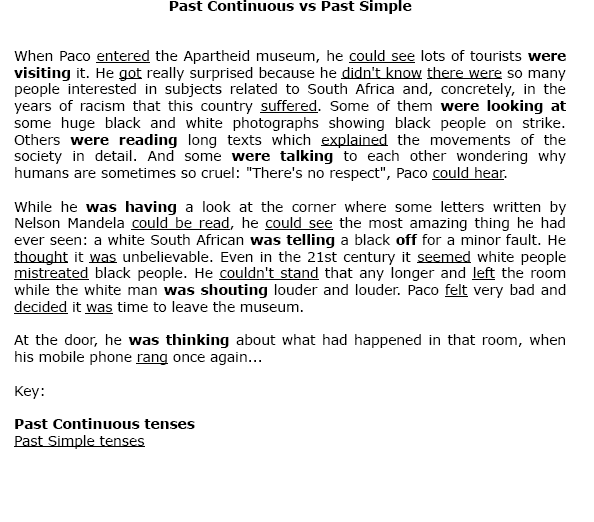5. Solved exercises

|
| By jasonEscapist. C. Commons |
Read the passage paying special attention to the tenses used. Underline the verbs in the Past Continuous Tense and those in the Past Simple. Then answer the following questions:
1. According to the text, had the black man done something really important? Explain your answer.
2. According to the text, does Paco think the Apartheid was reasonable? Explain your answer.
If you click below, you'll find out some expressions used in the passage and some possible answers to the questions. You will also be able to get the key for the past continuous and past simple tenses in the text.
As you can see, the Past Continuous tense is normally used to refer to actions that were in progress at a specific moment in the past. On the contrary, the past simple refers to an action that at a specific moment in the past was complete.
Remember that questions and negatives of these tenses are formed in completely different ways: The past simple needs did (past simple of "to do") and the Past Continuous doesn't need any auxiliary verb to make questions and negative sentences. Have a look at the following examples:
| Past Simple |
Past Continuous | |
| Question | Did Paco visit the museum on his own? | Were the people in the museum talking to a black man? |
| Negative | Paco did not (didn't) answer the phone. |
He wasn't walking in when the mobile rang. |
As has already been seen, the Past Simple tense is very frequently used in English. Mainly when we narrate past events. Quite frequently, we are told to tell stories that took place in the past, so, it is important that you master past tenses.
It is also very frequent that we modify nouns in English by means of adjectives. Thus, remember first that when adjectives are in attributive position (that is, they are in the noun phrase), they are placed in front of nouns (in Spanish adjectives are normally placed after nouns). It is also important that you know that, in almost all languages in the world, adjectives have three degrees: positive, comparative and superlative. Have a look at the following table:
| Adjective | Positive degree | Comparative degree | Superlative degree |
| hot, big |
hot, big |
hotter, bigger | hottest, biggest |
| lazy, funny |
lazy, funny |
lazier, funnier |
laziest, funniest |
| surprised, amazing | surprised, amazing |
more surprised, more amazing |
most surprised, most amazing |
| good, bad |
good, bad |
better, worse |
best, worst |
The positive degree is used to modify nouns, and the comparative and superlative ones are used to compare the qualities of nouns. So, comparative and superlatives are very frequently used when giving opinions and writing opinion essays.
 |
| By Oliver Hammond. C. Commons |
- An introduction where the topic and the author’s opinion are stated clearly.
Write an opinion essay of about 150 words answering the following question:
Do you think racism is a social problem today?
